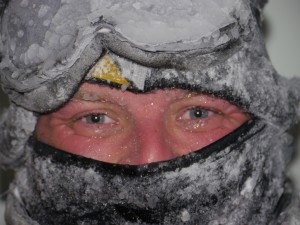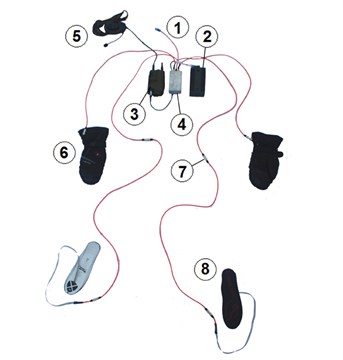Choosing the best equipment and clothing for a six-month polar expedition in near total darkness amid the harshest conditions on the planet is, not surprisingly, vital to success. There is a huge amount of high-tech clothing options available on the market nowadays, and before we could settle on the best combinations of inner and outer gear for comfort, fit and function at variable work rates during the expedition we had to carry out extensive testing in the lab, cold chambers and in the field. To find out more about how the kit was selected, check out our Preparations and Training section.
There was a myriad of different types of clothing that were tested in the cold chamber trials. The images and notes below are representative of the kind of set-up we will be using on this expedition and what was trialled at the final cold chamber test at Millbrook Proving Grounds. This is not the definitive list. It is the baseline set of equipment which will be adjusted according to personal preferences and circumstance (for example, some people prefer merino base layers over synthetic). During the actual traverse there will be variations on the set-up below, and other manufacturers’ clothing are likely to be used. These images also do not cover the additional PPE that will be required for different tasks in and around the vehicle. For a full list of all our clothing sponsors, check out our Partners and Sponsors pages.
Base Layers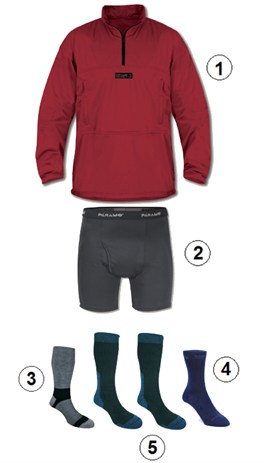
The base layers are key for wicking moisture away from the skin. This makes for much greater comfort and is essential to stop prevent excessive cooling.
1. Paramo Explorer Pull On
2. Paramo Cambria Boxers
3 & 4. Bridgedale Coolmax and Thermal liner socks – the choice of which model will vary depend on the activity levels anticipated for the tasks ahead that day.
5. The Bridgedale Summit proved very effective especially when two pairs were worn.
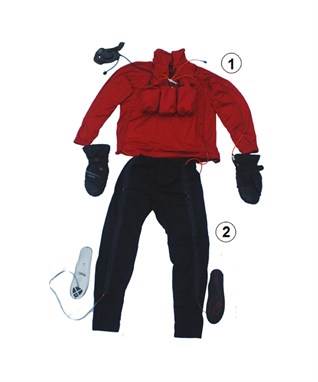 Second Layer
Second Layer
This second layer was selected to house the power loom (shown) to ensure that the battery and cables were kept warm. The clothing layers outside of this will vary depending upon the
time of year and activity and level whereas this layer should always be part of the mix.
1. Paramo Mountain Pull On. This was modified by the development team at Paramo to house the battery pack, radio and power distribution system in pockets across the chest. It also has sewn-in cable guides from the chest to the cuffs.
2. Paramo Stretch Pants. Modified to guide the power cables down the outside of the leg.
Power Loom
1. Cable to the helmet for powering the integrated head torch and the heated visor when fitted.
2. Tracer Battery pack.
3. Eagle Close Combat Radio
4. Allied Associates bespoke power distribution unit.
5. Radio headset
6. Heated gloves
7. Cable connection at waist level – all cable connections feature a twist lock for greater security.
8. Heated boot insole.
Mid/Outer Layer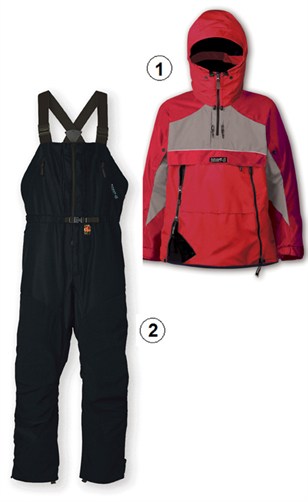
There will be times, especially towards the start and finish of the expedition, when this may be the outer layer.
The chamber tests were focussed on the coldest portion of the crossing for which these items would be considered very much mid-layer.
1 Paramo Aspira smock. With its large from pocket it is a very good working piece of clothing.
2. Aspira Salopettes. With reinforced knees these proved to be excellent working trousers in Sweden and in the chamber.
Outer Layer – Option 1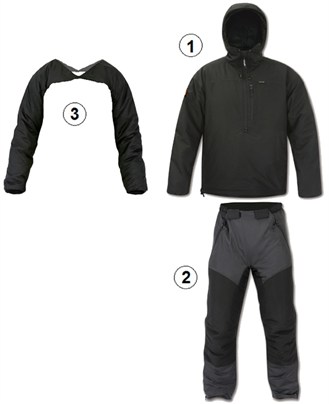
These feature synthetic down and are effective across in what would normally be considered very cold climates.
1. Torres Smock
2. Torres Trousers
3. Torres sleeves – we first though this was a strange concept but these additional sleeves keep your arms warm and so assist with maintenance of blood flow to the hands whilst not overheating the torso. They will be particularly useful for activities such kite skiing. The chamber testing showed a distinct improvement in hand temperature when this was worn.
Outer Layer – Option 2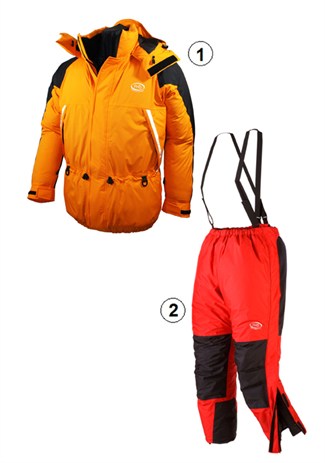
These items are the ‘last layer of defence’ against the most extreme cold. These are enhanced versions of PHD’s already top of the range equipment. Wearing them when not in coldest of climates quickly becomes uncomfortable.
1. PHD Omega jacket
2. PHD Omega trousers
Headwear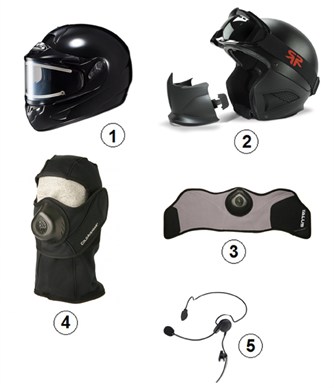
1. HJC skidoo helmet for the crevasse detection group. The thermal and noise insulation offered by this is ideal for the long exposure periods associated with this task.
2 Ruroc helmet – more multipurpose helmet for working around the vehicle, high levels of activity requiring greater visibility whilst still be protected from the elements.
3 & 4. Cold Avenger masks. These use exhaled air to warm the cold air being inhaled. Worked well in the first chamber trials and in Sweden.
5. Sonic ‘Breeze’ headset. A lightweight system that can be worn with any headwear combination.
Gloves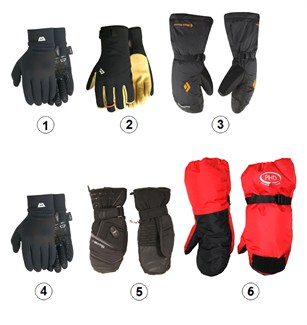
There will be many different task-specific glove combinations employed, but these are two that we found to be very effective.
For those requiring greater dexterity:-
1. Mountain Equipment Touch Grip
2. Mountain Equipment Randonee
3. Black Diamond Absolute Mitt (outer glove)
For the two-man ski team:-
4. Mountain Equipment Touch Grip
5. Snowlife Heated Mitt
6. PHD ‘Supermitt’ – bespoke manufacture to very high level of insulation.
Footwear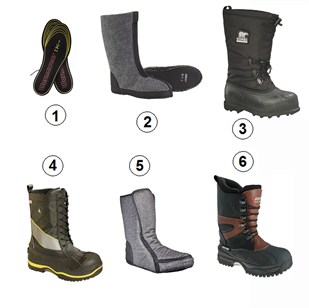
Here again the task will determine the choice of footwear. As a general usage cold weather boot this combination worked well (note: specialist ski boots were also examined during the trials)
1. Warmawear heated insole
2. Sorel felt innerboot
3. Sorel Glacier boot – rated to -70C
4 Baffin Apex 4000 – rated to -100C
5 Baffin felt inner boot
6 Baffin Pola-MP01 Safety Boot – rated to -100C
